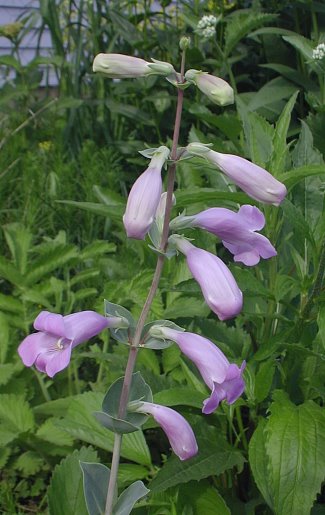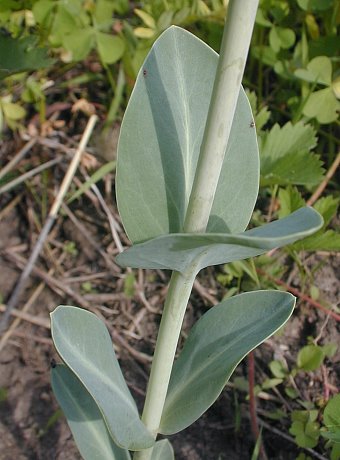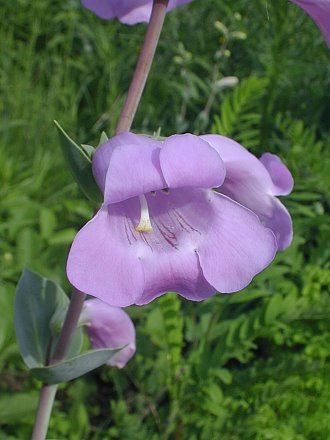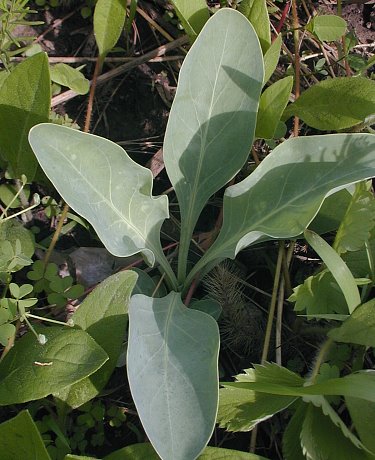 Description:
This is a short-lived perennial plant that forms a basal rosette during
its first year, after which it produces one or more flowering stalks
about 1-3½' tall from a thick rootstock. The basal leaves (2-5" long
and 1-3" across) are pale grayish green or bluish green, ovate to
obovate in shape, smooth along their margins, and glabrous,
tapering either gradually or abruptly into petioles. They
have a rather succulent texture. The stems of
flowering plants are whitish green to pale red, terete (circular in
cross-section), glabrous, and somewhat glaucous. The leaves along
these stems are arranged oppositely; they are 2-4" in length and 1-2½"
across. These latter leaves are pale grayish green to bluish green,
ovate to ovate-cordate in shape, smooth along their margins, and
glabrous; their tips are blunt. The leaves of each lower stem are
sessile, while the smaller upper leaves often clasp the stem. Like the
basal leaves, the opposite leaves have a rather succulent texture. From
the axils of opposite leafy bracts (up to 1¼" long and ¾" across),
there develops pairs of 1-3 flowers on short slender pedicels, forming
a narrow raceme about ½-1½' long. Each flower has a pinkish
lavender corolla up to 2" long, a pale grayish green or bluish green
calyx with 5 teeth, a pistil with a single white style, and 5 stamens.
The corolla is tubular-trumpet shaped and slightly flattened; it has an
upper lip with two rounded lobes and a lower lip with 3 rounded lobes.
Within the throat of the corolla, there are fine purple veins that
function as nectar guides. Along the upper outer surface of the
corolla, there is a slender longitudinal ridge. The glabrous
calyx is less than ½" in length; its teeth are lanceolate. The tip of
the
white style, where the stigma occurs, is slightly swollen. The leafy
bracts of the flowers
are similar in appearance to the opposite leaves, except they are
smaller in size. Similar to the upper leaves, their bases clasp the
stem. The blooming period occurs from late spring to early
summer, lasting about 3 weeks. Each flower remains in bloom for only a
short time. There is no floral scent. The flowers are replaced by ovoid
seed capsules that are a little longer than the toothed calyx. Each
capsule
contains numerous small seeds. The seeds are distributed to a limited
extent by the wind when the stems of flowering plants sway back and
forth. The root system consists of a stout taproot with coarse
secondary roots. This taproot extends deep into the soil.
Description:
This is a short-lived perennial plant that forms a basal rosette during
its first year, after which it produces one or more flowering stalks
about 1-3½' tall from a thick rootstock. The basal leaves (2-5" long
and 1-3" across) are pale grayish green or bluish green, ovate to
obovate in shape, smooth along their margins, and glabrous,
tapering either gradually or abruptly into petioles. They
have a rather succulent texture. The stems of
flowering plants are whitish green to pale red, terete (circular in
cross-section), glabrous, and somewhat glaucous. The leaves along
these stems are arranged oppositely; they are 2-4" in length and 1-2½"
across. These latter leaves are pale grayish green to bluish green,
ovate to ovate-cordate in shape, smooth along their margins, and
glabrous; their tips are blunt. The leaves of each lower stem are
sessile, while the smaller upper leaves often clasp the stem. Like the
basal leaves, the opposite leaves have a rather succulent texture. From
the axils of opposite leafy bracts (up to 1¼" long and ¾" across),
there develops pairs of 1-3 flowers on short slender pedicels, forming
a narrow raceme about ½-1½' long. Each flower has a pinkish
lavender corolla up to 2" long, a pale grayish green or bluish green
calyx with 5 teeth, a pistil with a single white style, and 5 stamens.
The corolla is tubular-trumpet shaped and slightly flattened; it has an
upper lip with two rounded lobes and a lower lip with 3 rounded lobes.
Within the throat of the corolla, there are fine purple veins that
function as nectar guides. Along the upper outer surface of the
corolla, there is a slender longitudinal ridge. The glabrous
calyx is less than ½" in length; its teeth are lanceolate. The tip of
the
white style, where the stigma occurs, is slightly swollen. The leafy
bracts of the flowers
are similar in appearance to the opposite leaves, except they are
smaller in size. Similar to the upper leaves, their bases clasp the
stem. The blooming period occurs from late spring to early
summer, lasting about 3 weeks. Each flower remains in bloom for only a
short time. There is no floral scent. The flowers are replaced by ovoid
seed capsules that are a little longer than the toothed calyx. Each
capsule
contains numerous small seeds. The seeds are distributed to a limited
extent by the wind when the stems of flowering plants sway back and
forth. The root system consists of a stout taproot with coarse
secondary roots. This taproot extends deep into the soil.

Cultivation:
The preference is full sun, dry conditions, and poor soil containing
rocky material or sand. This plant is easy to grow in locations that
are sunny and well-drained, but it is rather short-lived. However,
its seeds are fairly easy to germinate. Foliar disease is rarely
troublesome; the biggest threat is root rot from poorly drained soil.
Sometimes spider mites can be found on the foliage, but they appear to
cause little damage. This plant has excellent drought resistance.
Range & Habitat:
The native Large-Flowered Penstemon occurs in only a few northern or NW
counties in Illinois (see Distribution
Map),
where it is rare and state-listed as 'endangered.' This plant is more
common in states that are located to the west of the Mississippi River.
Habitats include dry sand prairies, dolomite prairies, and gravelly
hill prairies. Because of the showy flowers, Large-Flowered Penstemon
is more often found in flower gardens, from where it rarely escapes.
Fire is supposed to be harmful to the ecological success of this plant
because its growing buds remain above ground. In its natural habitat,
significant wildfires rarely occur because of the sparse vegetative
cover.

Faunal Associations: The flowers are cross-pollinated by bumblebees and other long-tongued bees, including Osmia distincta and Synhalonia dubitata. These latter two bees appear to prefer the flowers of Penstemon spp. over other species. One long-tongued bee, Xylocopa virginica (Large Carpenter Bee), perforates the base of the corolla from the outside to rob nectar from Large-Flowered Penstemon. An unusual wasp, Pseudomaris occidentalis, is a specialist pollinator (oligolege) of Penstemon spp. Like many bees, this wasp uses nectar and pollen to feed its larvae. While the more western range of this wasp overlaps with the range of Large-Flowered Penstemon, it has not been observed in Illinois. Other floral visitors include pollen-seeking Halictid bees, masked bees (Hylaeus spp.), and Syrphid flies. Insects that feed destructively on the foliage and other parts of Penstemon spp. are uncommon, but they include the caterpillars of a moth, Elaphria chalcedonia (Chalcedony Midget), and Spharagemon collare (Mottled Sand Grasshopper). At the present time, information about the relationships between Large-Flowered Penstemon and vertebrate animals is unavailable.

Photographic
Location:
The photographs were taken at the webmaster's wildflower garden in
Urbana, Illinois. The plants are an Illinois ecotype of this species
from nursery-grown material.
Comments:
Both the foliage and flowers of Large-Flowered Penstemon are beautiful
and distinctive. Unfortunately, the blooming period of the flowers is
rather short, but you can't have everything. Because of its distinctive
bluish foliage and large flowers (up to 2" in length), this species is
easy to distinguish from other Penstemon
spp. that are native to Illinois. However, a non-native
species from the west, Penstemon
cobaea
(Showy Penstemon), is somewhat similar in appearance and its flowers
are equally large in size. Unlike Large-Flowered Penstemon, this latter
species has pubescent stems, while its upper leaves and bracts have
bases that are sessile, rather than clasping. Showy Penstemon has
naturalized in Kane County, Illinois.